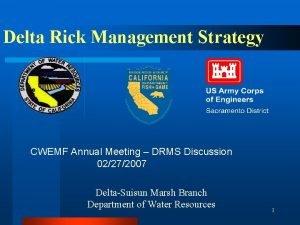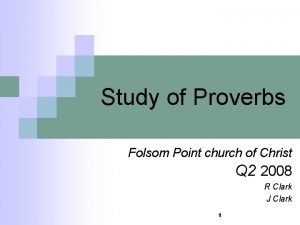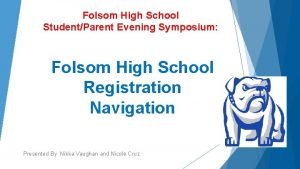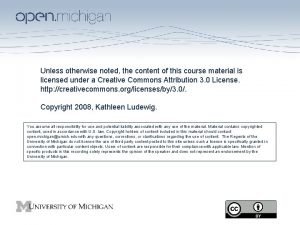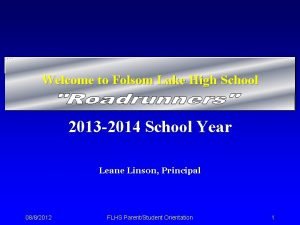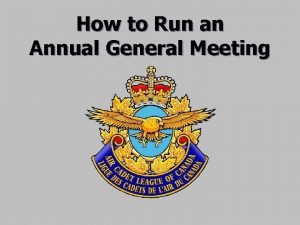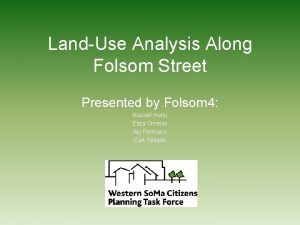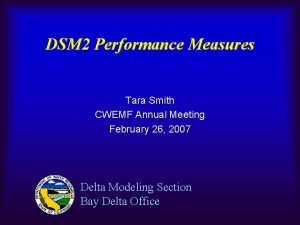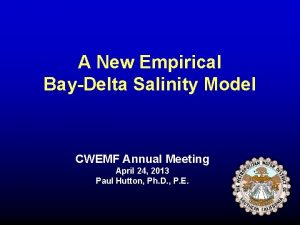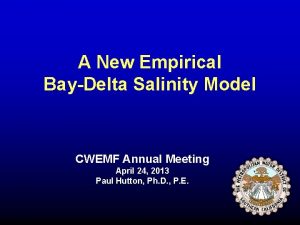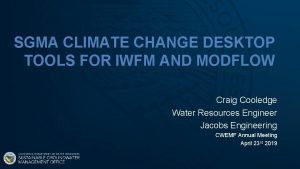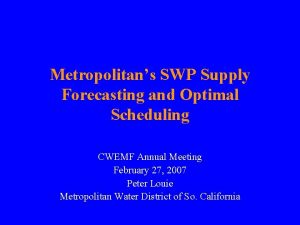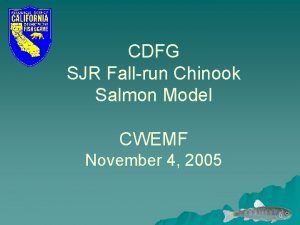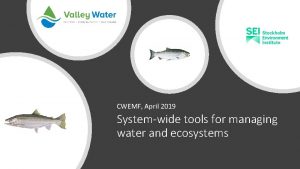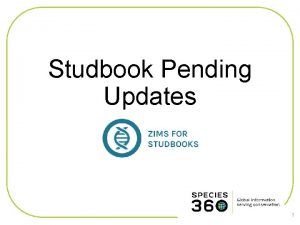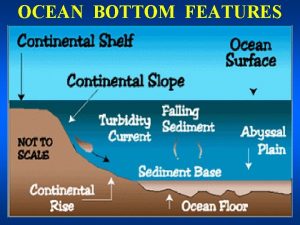Updates on IWFM Features CWEMF Annual Meeting Folsom















- Slides: 15

Updates on IWFM Features CWEMF Annual Meeting Folsom, California April 22 – 24, 2019 Emin Can Dogrul California Department of Water Resources

Outline l Model feature tagging l Multi-model simulations l IWFM Application Programming Interface (API) l Upcoming developments l Announcements

Model Feature Tagging l Issue: • IWFM model features (nodes, elements, stream nodes, stream reaches, etc. ) needed to be numbered sequentially, starting from 1 • Difficult and error-prone to modify grid, add stream nodes/reaches, etc. after a model is built l Solution: • Model feature tagging: Removed requirement of numbering model features sequentially, starting from 1; i. e. feature numbers are tags, not indices l Benefits: • Allows easy grid modification, local grid refinement, addition/deletion of stream nodes/reaches • Carving out child models from parent models (e. g. create a local model by carving it out from C 2 VSim-FG) • IWFM automatically identifies the stream network upstream-downstream orientation

Multi-Model Simulations: Overview l Initially requested by a user for a specific IWFM project l Ability to run multiple (neighboring), independently developed IWFM models concurrently l Neighboring models can be linked together and iterated back-and-forth at each timestep until flow between the models converge l Uses Fortran coarrays

Multi-Model Simulations: Linkage points

Multi-Model Simulations: Linkage points l Groundwater flow in the horizontal • Grid alignment at model interfaces is not required • Multiple nodes in one model can be linked to a single node in another model

Multi-Model Simulations: Linkage points l Groundwater linkage in the horizontal • Grid alignment at model interfaces is not required • Multiple nodes in one model can be linked to a single node in another model l Groundwater linkage in the vertical • Stratigraphy alignment at model interfaces is not required • Multiple aquifer layers in one model can be linked to a single layer in another model • IWFM computes linkage conductances based on hydraulic conductivity, layer thickness, effective length along the boundary nodes and distance between the linked nodes A A

Multi-Model Simulations: Linkage points l Stream linkage • Stream flows from one model can flow into another model • Bypasses exported from one model can be imported into another model l Water supply linkage • Diversions from one model can be delivered to another model • Currently, these diversions cannot be adjusted automatically to meet demand in another model

Multi-Model Simulations: Linkage points l Other linkages (not yet implemented) • Pumping in one model delivered to another model • Rainfall runoff and agricultural/urban return flow generated in one model flowing into stream nodes of another model

Multi-Model Simulations: Benefits l Local models can be linked to a regional model (e. g. C 2 VSim) for dynamic boundary conditions l Models developed separately by neighboring GSAs can be linked to test the validity of and improve the boundary conditions l Planned future developments: • Linking IWFM to WRIMS (i. e. C 2 VSim linked to reservoir systems analysis) • Combined with multi-model simulation will allow linking detailed, local-level water management to Central-Valleywide management

Multi-Model Simulations: Limitations l Models must have the same simulation period l Models must have the same timesteps l Currently, up to 8 models can be run concurrently

Other Improvements: IWFM Application Programming Interface (API) l Public release of IWFM API l For tool developers: • Allows access to IWFM model features and results through their software • Eliminates the need to duplicate IWFM logic within their code • Eliminates the need to update their code when IWFM code is updated l Procedures callable from Python, C#. NET, VB. NET, Java and VBA

Upcoming Developments l Parallel processing using Open. MP * On a laptop with 8 processors l Linking WRIMS and IWFM (i. e. implement reservoir systems analysis in IWFM) l Use of WRESL code in groundwater optimization studies in conjunction with SGMA l Develop web application for C 2 VSim-FG

Announcements l IDC workshop – April 30 -May 1 in Davis, CA l IWFM workshop – June 4 -7 in Davis, CA

Questions?
 Cwemf annual meeting
Cwemf annual meeting Sutter middle school website
Sutter middle school website Folsom prison famous inmates
Folsom prison famous inmates Folsom church of christ
Folsom church of christ Folsom high school registration
Folsom high school registration Folsom high school counselors
Folsom high school counselors Kinkos folsom
Kinkos folsom Folsom lake high
Folsom lake high Nrg virtual meeting
Nrg virtual meeting Aupha annual meeting
Aupha annual meeting How to run an annual general meeting
How to run an annual general meeting American epilepsy society annual meeting 2017
American epilepsy society annual meeting 2017 American psychiatric association annual meeting 2020
American psychiatric association annual meeting 2020 Aashto annual meeting 2015
Aashto annual meeting 2015 Nrg oncology meeting 2016
Nrg oncology meeting 2016 Grand lodge of ky
Grand lodge of ky
